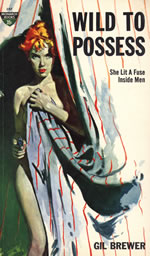Wild to Possess
 Cover Artist: Robert Maguire
Cover Artist: Robert MaguireBy: Brewer, Gil
Publisher: Monarch Books, Inc. (107)
Place of Publication:Derby, Connecticut
Catalog #: Kelley Box 204: PS3503 .R44984 W555 1959
Contributor: D. DiLandro
General
Era: 1950sAuthor as on Cover: Gil Brewer
Publication:1959
Original Date: 1959
Setting: small town; a shabby, Southern town with a population of "thirty or forty thousand." Action centers at the protagonist's shop/home (a renovated gas station) and a more upscale but not elegant beachfront bungalow; some forays into a rather upscale neighborhood as well as the town proper, but most of the action occurs outside of mainstream city life.
Plot Summary
Lew Brookbank is on the lam, knowing he'll be suspected for the murder of his wife and her lover. Although he found them already dead aboard Deke Clarkson's boat, it was Lew who, drunk, started the boat toward the open sea, attempting to hide the circumstantial evidence that pointed to him. Employed as a sign painter in Gulfville, Florida, a drunken Lew overhears a murder plot. He tracks down the would-be killers, who are involved in a ransom plot with one of the players' wives. Lew re-kidnaps the wife just as Herbert Clarkson appears to threaten Lew with his brother's disappearance. Florence, the kidnapee, is murdered at Lew's by her husband, who has tracked them down; Herbert is killed by Lew's girlfriend, and Lew is forced to attempt to flee the country by the original kidnappers, whose escape by boat is ruined by the boys' fighting and the rather unfortunate fact that they are trying to sail, unnoticed, through a scheduled regatta. Lew prevails and after considering the really, really great sex he's had with his girlfriend, Rita, Lew ostensibly decides to settle down -- knowing that there would be a penalty for his involvement, but satisfied that it would all "equalize."Major Characters
Lewis Brookbank "Lew" adult male, 40s, "tall, rangy, heavy-shouldered,"sign painterIsobel Delarno adult female, mid-20s, large, brown eyes, dark blonde curls, very good looking, owner/employee of an antique store
Ralph Hagan adult male, mid-30s, wears glasses, hen-pecked, owner/employee at a shoe store
Florence Hagan adult female, 20s, ink-black hair, cream-colored skin, housewife
Rita (no surname) adult female, 20s, slim, tall, tan, brown hair, receptionist/secretary
Ida DeCroix adult middle-aged female, Florende Hagan's mother, very wealthy, mark for the Delarno/Hagan blackmail scheme
Janice Brookbank adult female, late 20s, Lew's dead wife, found by him in her lover's arms, shot through the head
Deke Clarkson adult male, 30s, wealthy, Janice Brookbank's lover, owned The Bayou Belle, on which his and Janice's bodies were discovered by Lew